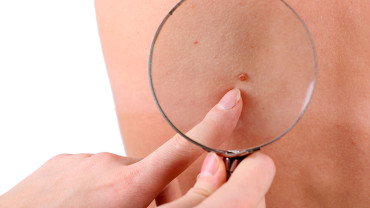If you are a patient at Sutton Ryan Dermatology, you are likely familiar with the dangers associated with indoor tanning and UV exposure. You may have quit those unhealthy habits, but now you’re still not sure what to worry about in regard to that new freckle or that mole that seems to be growing. Maybe it has been there your entire life and has recently started to change colors. Or, maybe one of your friends or significant others pointed out something to you that you didn’t realize was present. Regardless of the circumstances, familiarizing yourself with melanoma and its warning signs may not only cut down on the number of mole pictures you email or text to your friends, it may save your life or the life of your loved one.
I like to educate others about melanoma because it is the skin cancer with the most significant consequences. Recent studies have found that it is responsible for 75% of skin cancer deaths (as opposed to non-melanoma skin cancer). The bad news is that by current estimates, 1 in 50 people will develop melanoma this year. The good news is that the 5 year survival rate for melanoma, if detected before it spreads to lymph nodes, is 98% and has a favorable prognosis long term. Luckily, there are some easy guidelines to follow that may assist in early detection- just remember your ABCDE’s!
A- Asymmetry. If you draw a line through the middle, the two sides should match. If they don’t, the mole is asymmetrical. A mole that can be folded over on itself with matching borders is symmetrical, which is a reassuring feature.
B- Border. A benign mole typically has a well-defined border that is easily traceable with a pen. Melanomas typically have scalloped, uneven, or notched borders.
C- Color. Moles that have multiple different shades of brown or moles that are odd colors (some melanomas are red or white) can be worrisome. Typically benign moles are one color throughout.
D- Diameter. If the mole is larger than the size of a pencil head eraser (6 mm), this can be a warning sign. Benign moles tend to be smaller, although an early melanoma can be less than 6 mm.
E- Evolution. Be on the look-out for any mole that seems to be growing, changing color, or elevating. Also, if it displays a new symptom such as bleeding or crusting, it needs further evaluation.
If you notice any of the above characteristics when examining your moles, please don’t hesitate to contact us at Sutton Ryan Dermatology to schedule an appointment. We recommend annual full body skin examinations to everyone, but would love to see you sooner to take care of anything that may be causing you concern. Hope this gives you more confidence in checking over your skin!
All statistics herein are courtesy of: Skincancer.org, AAD.org
-Sarah Minarick, PA-C




Leave a Reply